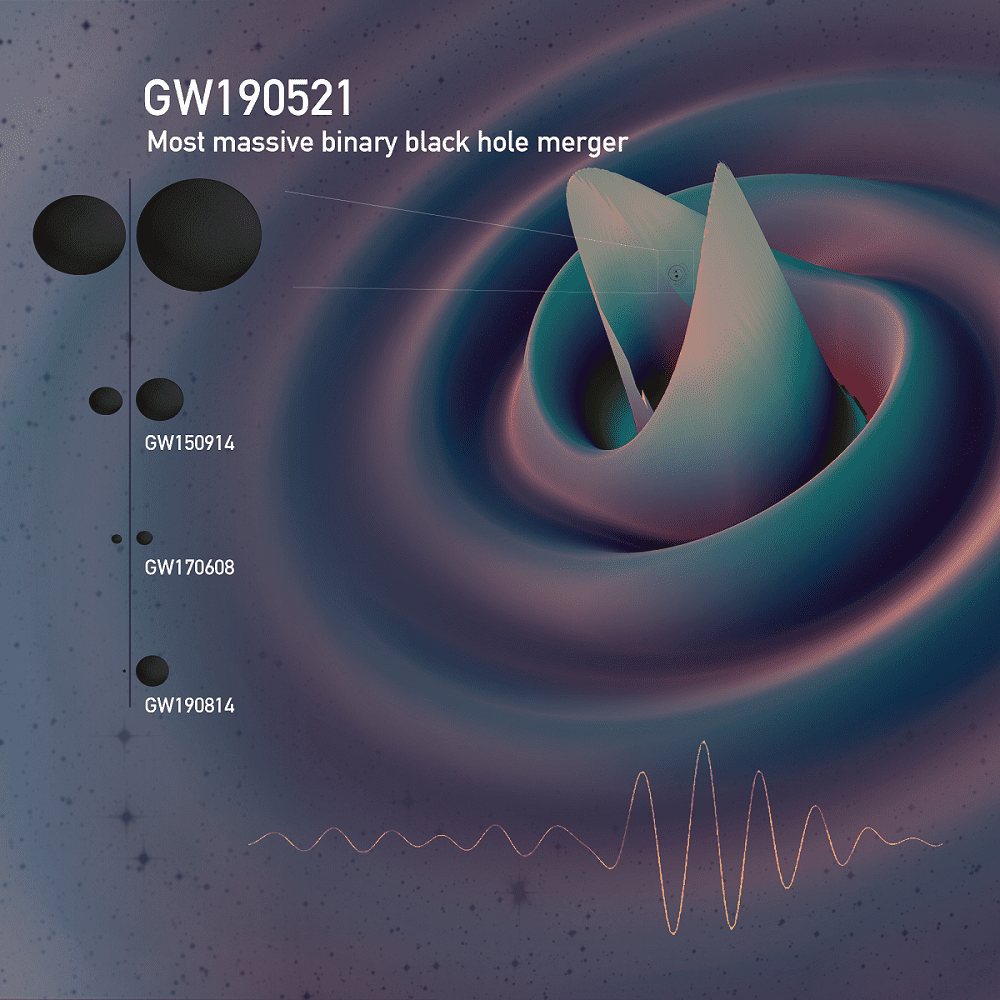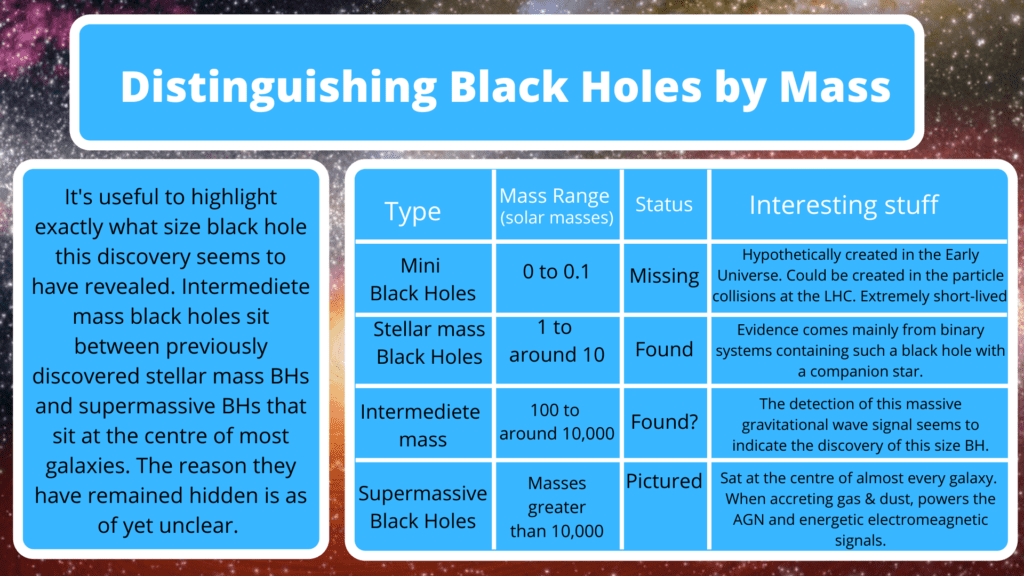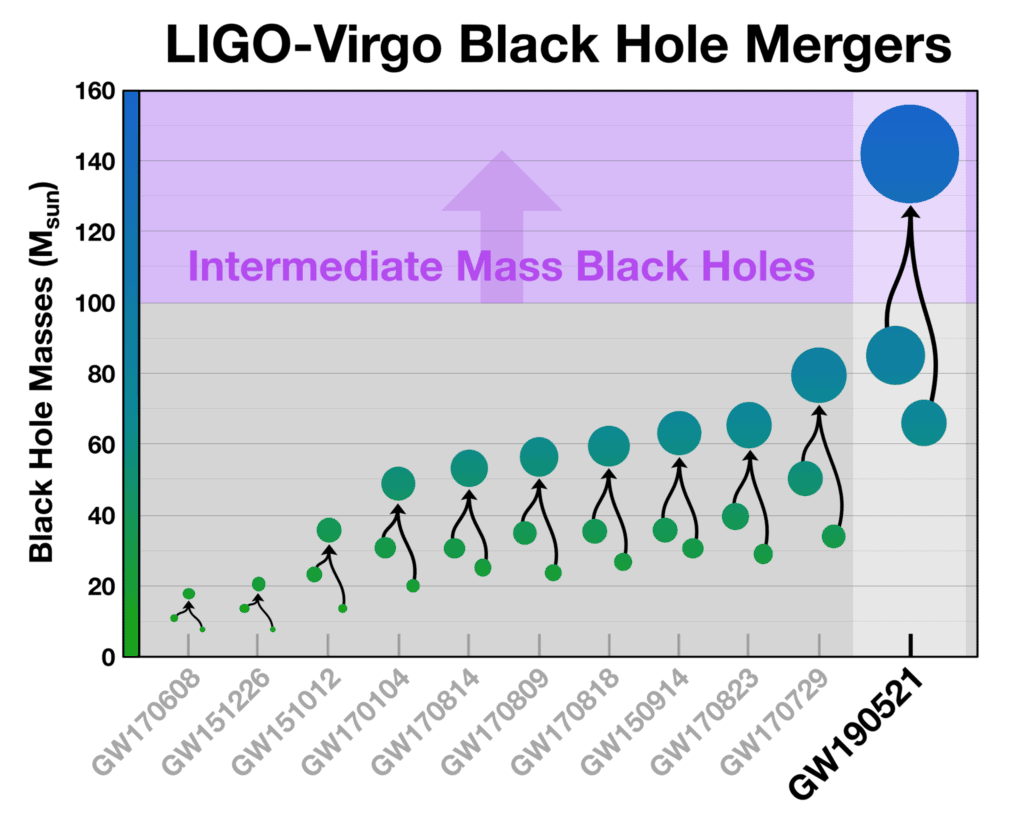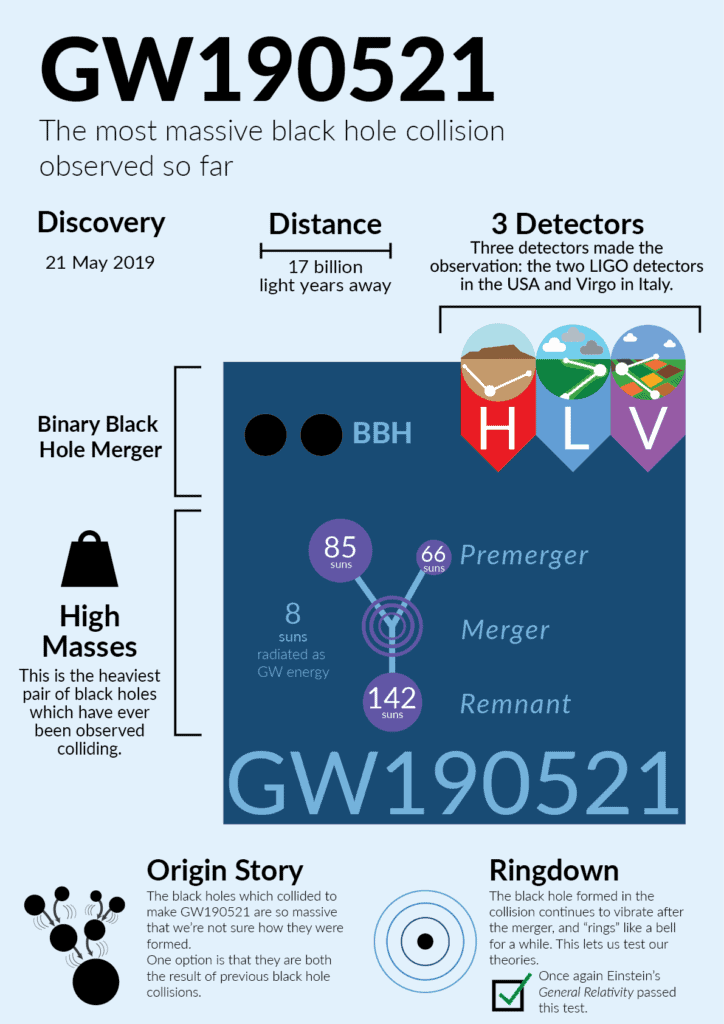Gravitational waves have been detected from what appears to be the largest black hole merger ever observed. The powerful and previously unobserved hierarchical merger resulted in an intermediate-mass black hole, an object never before detected.
A massive burst of gravitational waves equivalent to the energy output of eight Suns has been detected by the LIGO laser interferometer. Researchers at LIGO and its sister project VIRGO believe that the waves originate from a merger between two black holes. But, this isn’t your average black hole merger (if there is such a thing). The merger — identified as gravitational wave event GW190521 — is not only the largest ever detected in gravitational waves — but it is also the first recorded example of what astrophysicists term a ‘hierarchical merger’ occurring between two black holes of different sizes, one of which was born from a previous merger.
“This doesn’t look much like a chirp, which is what we typically detect,” says Virgo member Nelson Christensen, a researcher at the French National Centre for Scientific Research (CNRS), comparing the signal to LIGO’s first detection of gravitational waves in 2015. “This is more like something that goes ‘bang,’ and it’s the most massive signal LIGO and Virgo have seen.”

The Pennsylvania State University)
Even more excitingly, it seems that black hole birthed in the event has a mass of between 100–1000 times that of the Sun, putting it in the mass range of an intermediate-mass black hole (IMBH). Something that researchers have theorised about for decades, but up until now, have failed to detect.
The gravitational wave signal–spotted by LIGO on 21st May 2019–appears to the untrained eye as little more than four short squiggles that lasted little more than one-tenth of a second, but for Alessandra Buonanno, Principal Investigator of the LIGO Scientific Collaboration, whose group focuses on the development of highly-accurate waveform models, it holds a wealth of information. “It’s amazing, but from about four gravitational-wave cycles, we could extract unique information about the astrophysical source,” she tells ZME Science.
“The waves are fingerprints of the source that has produced them.”
Alessandra Buonanno, Principal Investigator of the LIGO Scientific Collaboration.
As well as containing vital information about black holes and a staggering merger event, as the signal originated 17 billion light-years from Earth and at a time when the Universe was half its current age, it is also one of the most distant gravitational wave sources ever observed. The incredible distance the signal has travelled may initially seem at odds with the fact that the Universe is only 14.8 billion years old, but the disparity arises from the fact our universe is not static but is expanding.

Details of the international team’s important findings are featured in a series of papers publishing in journals such as Physical Review Letters, and The Astrophysical Journal Letters, today.
Missing Intermediete-Mass Black Holes
Thus far, the black holes discovered by astronomers have either been those with a mass inline with that of larger stars–so-called stellar-mass black holes, or supermassive black holes, with masses far exceeding this. Black holes that exist between these masses have remained, frustratingly hidden. Until now.
“The LIGO and Virgo collaborations detected a gravitational wave corresponding to a very interesting black hole merger. This was named GW190521 and corresponds to two large black holes during the final orbit and merger,” Pedro Marronetti, program director for gravitational physics at the National Science Foundation (NSF) responsible for the oversight of LIGO, tells ZME Science.
“What makes GW190521 extraordinary in comparison to other gravitational wave events is the mass of the black holes involved, the product of the merger is a 142 solar mass black hole and the first object of its kind with mass above 100 solar masses but below a million solar masses to be discovered.”
Pedro Marronetti, program director for gravitational physics, the National Science Foundation (NSF)

Thus, the resultant black hole of 142 solar masses exists in that crucial, thus far undetected, mass range indicating an intermediate-mass black hole (IMBH).
“These black holes, heavier than 100 solar masses but much lighter than the supermassive black holes at the centre of galaxies — which can be millions and billions of solar masses — have eluded detection until now,” Marronetti says. “Additionally, the heavier of the original black holes with 85 solar masses also presents an enigma.”
Pair Instability and Hierarchical Black Hole Mergers
The enigma that Marronetti refers to is the fact that heavier of the two black holes that entered the merger, is of a size that suggests it too must have been created by a merger event between two, even smaller, black holes. “The most common channel of formation of black holes involves heavy stars that end their lives in supernova explosions,” the NSF program director points out. “However, this formation channel prevents the creation of black holes heavier than 65 solar masses but lighter than 130 solar masses due to a phenomenon called ‘pair-instability’.”
![This graphic shows the masses of black holes detected through electromagnetic observations (purple), black holes measured by gravitational-wave observations (blue), neutron stars measured with electromagnetic observations (yellow), and neutron stars detected through gravitational waves (orange). GW190521 is highlighted in the middle of the graphic as the merger of two black holes that produced a remnant that is the most massive black hole observed yet in gravitational waves. [Image credit: LIGO-Virgo/Northwestern U./Frank Elavsky & Aaron Geller]](https://cdn.zmescience.com/wp-content/uploads/2020/09/08-GW190521-Mass-Plot-Graveyard-1024x706.png)
As nuclear fusion ceases, there is no longer enough outward radiation pressure to prevent gravitational collapse. “The star suddenly starts producing photons that are energetic enough to create electron-positron pairs,” Marronetti explains. “These photons, in turn, create an outward pressure that is not strong enough to stop the star from collapsing violently due to its self-gravitational pull.”
This results in a difference in gravitational pressure between the star’s core and its outer layers. As a massive shock travels through these ‘puffed out’ outer layers they are blown away in a massive explosion. With smaller stars, this leaves behind an exposed core that becomes a stellar remnant such as a white dwarf, neutron star or black hole. But if the star is a range above 130 solar masses, but below 200 solar masses, the result is more disastrous.
“The resulting supernova explosion completely obliterates the star, leaving nothing behind– no black hole or neutron star is produced,” Marronetti says. “It will take stars heavier that 200 solar masses to collapse into black hole fast enough to avoid this complete disintegration.”

As Marronetti points out; this means that the 85-solar mass back hole could only be formed by the merger of two smaller black holes, as at these masses, collapsing stars can’t form black holes. “This is a quite unusual event that can only occur in regions of dense black hole population such as globular clusters,” the researcher adds. “GW190521 is the first detection that is likely to be due to this ‘hierarchical merger’ of black holes.”
Marronetti continues by explaining that a hierarchical merger consists of one or more black holes that were produced by a previous black hole merger. This hierarchy of mergers allows for the formation of progressively heavier and heavier black holes from an original population of small ones.
“We don’t really know how common these hierarchical mergers are since this is the first time we have direct evidence of one. We can only say that they are not very common.”
Pedro Marronetti, program director for gravitational physics, the National Science Foundation (NSF)
LIGO Delivering Discoveries and Surprises
The team uncovered the unusual nature of this particular merger by assessing the gravitational wave signal with a powerful state of the art computational models. Not only did this reveal that GW190251 originates from the most massive black hole merger ever observed and that this was no ordinary merger but a hierarchical merger, but also crucial information about the black holes involved in the event.
“The signal carries information about the masses and spins of the original back holes as well as their final product,” Marronetti adds, alluding to the fact that the LIGO -VIRGO team were able to measure that spin and determine that as the black holes circled together, they were also spinning around their own axes. The angles of these axes appeared to have been out of alignment with the axes of their orbit. This misaligned spin caused the black holes to ‘wobble’ as they moved together.

“Our waveform models were used to detect GW190521 and also to interpret its nature, extracting the properties of the source, such as masses, spins, sky location, and distance from Earth. For the first time, the waveform models included new physical effects, notably the precession of the spins of the black holes and higher harmonics,” Buonanno says. “What we mean when we say higher harmonics is like the difference in sound between a musical duet with musicians playing the same instrument versus different instruments.
“The more substructure and complexity the binary has — for example, black holes with different masses or spins—the richer is the spectrum of the radiation emitted.”
Alessandra Buonanno, Principal Investigator of the LIGO Scientific Collaboration.
Unanswered Questions and Future Investigations
Even with the staggering amount of information the team has been able to collect about the merger that gave rise to the signal GW190251, there are still some unanswered questions and details that must be confirmed.

The LIGO-VIRGO detectors use two very distinct methods to search the Universe for gravitational waves, an algorithm to pick out a specific wave pattern most commonly produced by compact binary mergers, and more general ‘burst’ searches. The latter searches for any signal ‘out of the ordinary’ and it’s the mechanism via which the researchers found GW190215.
Morronetti expresses some surprise that the methods used by the team were able to unlock these secrets, believing that this result demonstrates the versatility of LIGO. “My main surprise was that this event was detected using a search algorithm that was not specifically created to find merger signals,” says the NSF director. “This is the first detection of its kind and shows the capability of LIGO to detect phenomena beyond compact mergers.”
“This is of tremendous importance since it showcases the instrument’s ability to detect signals from completely unforeseen astrophysical events. LIGO shows that it can also observe the unexpected.”
Pedro Marronetti, program director for gravitational physics, the National Science Foundation (NSF)
This leaves open the small chance that the signal was created by something other than a hierarchical merger. Perhaps something entirely new. The authors hint at the tantalising prospect of some new phenomena, hitherto unknown, in their paper, but Marronetti is cautious: “By far, the most likely cause is the merger of two black holes, as explained above. However, this is not as certain as with past LIGO/Virgo detections.
“There is still the small chance that the signal was caused by a different phenomenon such as a supernova explosion or an event during the Big Bang. These scenarios are possible but highly unlikely.”
Confirming the nature of the event that gave rise to the GW190251 signal is something that the LIGO team will be focusing on in the future as the interferometer also searches for similar events via the gravitational waves they emit. “
With GW190521, we have seen the tip of the iceberg of a new population of black holes,” Buonanno says, adding that LIGO’s next operating run (O4) will explore a volume of space 3 times larger than the current run (O3). “Having access to a larger number of events, which were too weak to be observed during O3, will allow us to shed light on the formation scenario of binary black holes like GW150921.”


